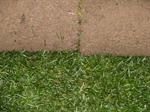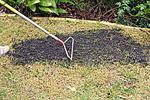
Become Adept at Turf Repair and Renovation
Irrespective of how skilled you might be, there is always a danger of overlooking something important when you carry out a turf inspection. If you use a checklist, or fill out a well-designed ‘report form’ you are much less likely to overlook anything. The best way to carry out an inspection is systematically. This is a simple way of ensuring you look at everything important when you are doing a site inspection. A checklist is simply a list of things which you should check (or inspect) when you are trying to make an evaluation. Ideally you should make up a checklist which is tailored to the situation you are about to inspect. You may base this checklist on a standard one, modified for each job. A simpler way may be to maintain a standard checklist.
Enhance your turf care skills
Take this course to learn about industry practices for undertaking turf repairs and renovating damaged turf. Learn to recognise symptoms of poor turf health, carry out inspections, and perform operations to maintain turf longevity. Find out about irrigation systems for turf, and gain an insight into the turf production industry.
ACS student comment: "In my role within a large Aged Care Facility a great deal of my employment is spent in the area of Turf management and garden care/refurbishment. With ACS I was able to study at my own pace allowing me to put into practise and thoroughly research the subject matter broadening my knowledge and study experience further. I enjoyed the way in which the subject matter was presented as it allowed you to study each subject further, allowing for greater depth, clarity and knowledge. Overall there are not many areas in which the course subject matter will not turn out to be invaluable, everything is covered to allow you to become successful within your own business or place of employment. A big thank you to Gavin Cole [tutor] and all at ACS. It was a pleasure to study with ACS, look forward to further study." (Craig Ledbury, Australia, Turf Repair & Renovation)
10 Lessons with Set Tasks, 10 Assignments. Course notes. Real Learning.
Lesson Structure
There are 10 lessons in this course:
- Understanding Turf Deterioration - physiological and biological responses.
- Repair & Renovation Equipment - use and repair of applicable equipment.
- Turf Cultivation Techniques
- Health Improvement Techniques -pest control, feeding, watering, etc.
- Optimising Turf Usage
- Replacing Damaged Turf - techniques for replacement.
- Renovation of Degraded Turf - techniques to repair and renovated turf.
- Eradicating Turf Weeds
- Treating Aeration & Drainage Problems - compaction, etc.
- Managing a Turf Nursery.
Each lesson culminates in an assignment which is submitted to the school, marked by the school's tutors and returned to you with any relevant suggestions, comments, and if necessary, extra reading.
Aims
- Compare the characteristics of different turfs with reference to hardiness, pest & disease resistance, tolerance to play, suitability for different applications, etc
- Explain different turf problems (including; soil problems, pest & disease weed, environmental, etc)
- Explain the effect of various adverse situations on the physiology of turf plants.
- Carry out turf consultancy, conducting site inspections and giving appropriate recommendations.
- Develop solutions for the repair of damaged turf.
- Identify the cause of deteriorating condition in a selected turf
- Explain different repair techniques for control of problems identified.
- Compare different solutions for the problem identified.
- Develop turf renovation programs for different types of turf facilities
- Compare renovation programs for different turf facilities
- Identify when renovation becomes economically prudent for different facilities .............and lots more!

Tutor Comment:
“Aimed at landscapers, home gardeners, and other turf industry workers, this course enlightens the student as to everything that one could possibly wish to know about turf care. Here, you will discover how to control even the most chronic of turf diseases and learn the ultimate methods to produce lush, dense, green turf.” - Gavin Cole B.Sc., Psych.Cert., Cert.Garden Design, MACA, ACS Tutor.
INSPECTING DETERIORATED TURF
Irrespective of how skilled you might be, there is always a danger of overlooking something important when you carry out an inspection. If you use a checklist, or fill out a well designed "report form" you are much less likely to overlook anything. The best way to carry out an inspection is systematically.
Checklists
This is a simple way of ensuring you look at everything important when you are doing a site inspection. A checklist is simply a list of things which you should check (or inspect) when you are trying to make an evaluation. Ideally you should make up a checklist which is tailored to the situation you are about to inspect. You may base this checklist on a standard one, modified for each job. A simpler way may be to maintain a standard checklist.
Checklist (Incomplete Example)
1. Turf Varieties (major and minor)
2. Soil type
3. Drainage (surface and sub surface)
4. Compaction/aeration
5. Acidity (pH) and Conductivity (EC)
6. Plant fertility (Nutrient deficiencies/toxicities)
7. Physical damage (to turf or surface)
8. Recent cultural treatments (eg. rolling, spraying, aeration, mowing, etc.)
9. Usage (frequency and type)
REPORT FORMS
A report form is similar to a checklist, but more structured, providing in itself a format for recording information as an inspection is undertaken. It incorporates spaces for information to be recorded, and spaces for recommendations to be written down. A report form is generally designed to be used repeatedly in a variety of different inspections; and as such, it needs to be designed more carefully and in a generic way (ie. in a way that relates to any sort of turf inspection which you are likely to undertake).
Report Form (An Incomplete Example)
Site being inspected:
Address .................................................................................................
Type of Facility Ornamental Lawn or Sports Turf
Description of the Turf ..........................................................................
Inspection Undertaken by .......................................................................
Date of inspection ..................................................................................
Turf Health Indicators
|
Characteristic
|
Current Status
|
Recommendation(S)
|
|
Dominant Turf Plant Cultivars
|
|
|
|
Minor Turf Cultivars
|
|
|
|
Significant Weeds
|
|
|
|
Turf Cover (Are there bare patches?)
|
% cover =
|
|
|
Organic Content in Soil
|
Low/Adequate/Excellent/Excessive
|
|
|
Clay Content of Soil
|
Low/Adequate/Excessive
|
|
|
Soil Type (eg. Loam, Sand, Clay)
|
|
|
|
Soil pH
|
|
|
|
Soil Conductivity
|
|
|
|
Surface Drainage (slope, etc)
|
|
|
|
Sub surface Drainage
|
|
|
|
Water Table (close to surface or not?)
|
|
|
|
Plant Nutrition Symptoms
|
|
|
|
Diseases Present
|
|
|
|
Pests Present
|
|
|
|
Physical Damage Identified
|
|
|
|
Other ........................
|
|
|
Maintenance Practices
What is undertaken on a routine basis and how often?
Spraying ................................................................................
Fertilising .............................................................................
Irrigation ..............................................................................
Mowing ..................................................................................
Aeration ................................................................................
Rolling .................................................................................
Other....................................................................................
(Continued overleaf)
Changes in Turf Condition
Has deterioration in condition been gradual or fast? .....................
What changes have occurred on or in the vicinity of the turf?
- changes to drainage patterns ...........................................................
- changes in vegetation, structures etc. ......................................................
- changes in usage of area? ...................................................................
- other .......................................................................................
Conclusions...................................................................................................
Recommendations..........................................................................................
Where To From Here?
This course is of value to people who have an interest in grass and turf surfaces. People who take this course are most likely those working in or aspiring to work in:
Turf maintenance
Green keeping
Lawn mowing
Sports turf maintenance
Grounds maintenance
Landscaping
Horticulture
Parks & gardens
The course will also be of value to people wishing to include a turf repair service as part of an existing mowing, gardening or landscaping business.